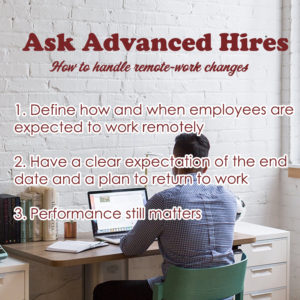Part advice column, part career resource, we are here to answer your questions about job searching, hiring, culture concerns, recruiting, and business in general. If you have a question you want us to answer, submit it HERE. Be sure to tune in every Monday as we answer the questions that YOU want to know the answers to.
Q: No one in our office knows what’s going on with coming back to the office. How can we handle remote work and any changes that might arise in that area?
Communication is one of the most important things a company can do for its employees. This is especially true during a worldwide pandemic that hasn’t shown any signs of stopping yet. Here’s some ways you can handle remote work changes and confusion:
- Define how and when employees are expected to work remotely: This might look different for each organization, but it’s something the company needs to figure out and disseminate to all employees as soon as possible. Maybe this means that some employees are staggered and will come back to the office part-time. Perhaps others will be remote full-time until the end of the year. Whatever you decide, you need to make sure it’s clearly communicated so there’s no confusion. If your company hasn’t done this, it’s worth contacting your supervisor and asking if there are any plans to do so.
- If this is a temporary arrangement have a clear expectation of the end date and a plan to return to work: Many companies have said that WFH is only temporary, which is fine, but in that case there needs to be an end date that people can plan for. There also needs to be a plan in place to protect employees when they return to the office. Checking the CDC website is helpful in this regards, as is checking your state laws and regulations. Push your company to give an exact end date to remote work so that people won’t be surprised or upset if it’s sprung upon them out of nowhere.
- Performance still matters: WFH works when the job is getting done. If employees are doing well with remote work and they aren’t essential to in-office activities, it’s better to allow remote work to continue. However, if output and work productivity goes down, it might be time to think about other options. Of course, these aren’t normal times and we must be lenient with the pressure we put on ourselves and employees, but massive changes in work quality are problematic. This is important for the employee to recognize too. If you feel your work quality has dipped because of WFH, contact your boss and see if there’s a possibility of coming back to the office, staggered or even with limited hours.






